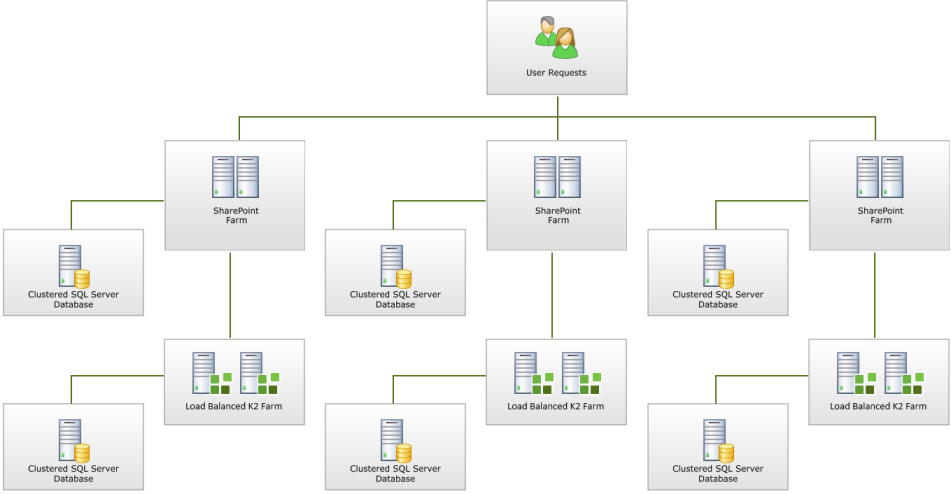Multiple SharePoint and K2 Farms
Building on previous topology descriptions, this install scenario can be leveraged in multi SharePoint farm environments to allow completely independent K2 farms per SharePoint farm. The expected volumes would be similar to a single farm installation, however as there are multiple farms scaled independently, there is near limitless ability to scale.
Similar to the Large Scale Install scenario, this scenario is specifically suitable for high work load environments. Each component is load balanced, and multiple dedicated databases allow for maximum growth and availability. Multiple databases are dedicated to individual load-balanced components to allow for maximum growth and availability.
Kerberos is mandatory for this configuration option. Both NLB and Kerberos must be configured correctly and must be able to communicate before K2 blackpearl is installed.
 |
Depending on the SharePoint product installed, either the MOSS, WSS, SharePoint 2010 Server or SharePoint 2010 Foundation components will be displayed for installation. Also depending on your MOSS environment, the application servers such as Excel Services, InfoPath Server, and Indexing can be split off onto a separate server. Refer to the SharePoint installation guidance for installation options. These servers will not be needed if only WSS is installed. |
The Multiple SharePoint and K2 farms Install scenario is shown below. Not all of the SharePoint features are shown here. Refer to the SharePoint documentation for installation guides and options.

Considerations for the Multiple SharePoint and K2 Farms Install
Useful to segment due to:
- Load
- Language
- Geography
- Legal requirements
- Operational ownership/support
Kerberos
 |
The default method for user authentication for new distributed installations is K2 Pass-Through Authentication. Kerberos is recommended for all configurations, machines and services in a distributed environment except for those that use OAuth (SharePoint 2013 and Azure Active Directory SmartObjects). |
Since the IIS server does not share a server with the K2 Server, the credentials will be passed as a result. As discussed earlier, whenever more than two hops are required, Kerberos must be configured.
Ensure that all Kerberos settings and necessary configuration takes place before attempting to install K2 blackpearl. To configure Kerberos, refer to the deployment considerations section on Kerberos later in this help file.
Network Load Balancing
NLB can be configured by using either the operating system or specific hardware. In either case, NLB configuration should be completed before installing K2 blackpearl.
When installing components that will be load balanced, the installation must be performed on each machine independently. In this install, each load-balanced component should have the full install on each NLB node.
SQL Server
The location of the SQL Server is not critical for a K2 installation, as long as the network connection speed to the K2 Server meets minimum requirements. It is also important that the DTC component is configured properly in order for communications between the K2 Server and the SQL Server can function properly. The SQL Server can share physical resources, be located on an independent platform, such as in this install, or it can be clustered. For more information regarding SQL Server clustering, refer to the Getting Started with SQL Server Failover Clustering documentation (http://msdn.microsoft.com/en-us/library/ms189134.aspx)
In most cases K2 databases are installed on an established SQL Server cluster for an existing environment. This is a common occurrence and the installation documentation takes this into consideration.
